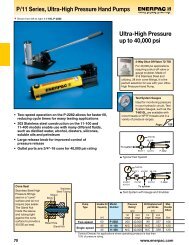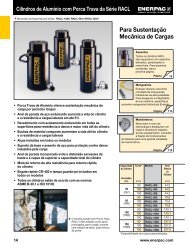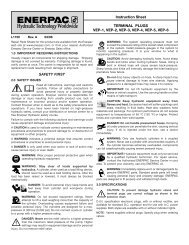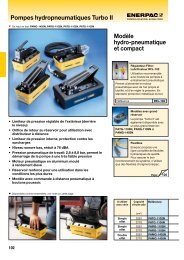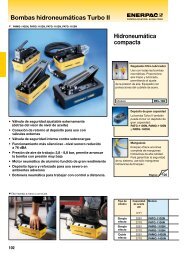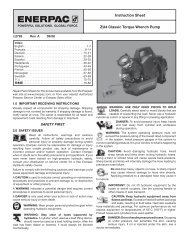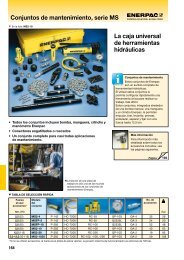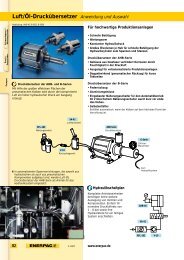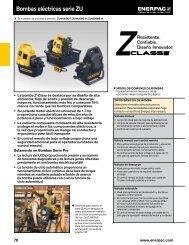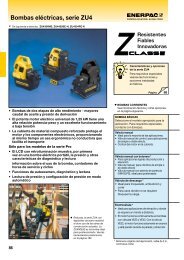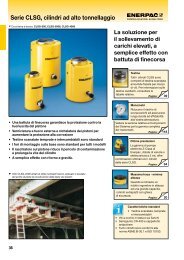- Page 1 and 2: Instruction Sheet S-Series Hydrauli
- Page 3 and 4: Instruction sheet Torque wrenches S
- Page 5 and 6: - Do not stand in the line of movem
- Page 7 and 8: Fig. C Fig. D 1 10 9 11 6 7 3.4 To
- Page 9: Fig. F 14 6 4 Operation 4.1 Prior t
- Page 13 and 14: • Remove the cylinder bush (25) b
- Page 15 and 16: Fig. L A B 6 Technical specificatio
- Page 17 and 18: 6.2.1 Metric system table S1500 S30
- Page 19 and 20: 7 Recommended spare parts 7.1 To or
- Page 21 and 22: 21 ENGLISH
- Page 23 and 24: Please contact Enerpac if the CD is
- Page 25 and 26: Manuel d'instructions Clé dynamom
- Page 27 and 28: Manuel d'instructions Clé dynamom
- Page 29 and 30: - Ne placez aucun objet entre le br
- Page 31 and 32: Fig. C Fig. D 1 10 9 11 6 7 3.2.2 R
- Page 33 and 34: Fig. F 14 6 4 Fonctionnement 4.1 Av
- Page 35 and 36: Fig. I Fig. J 15 15 15 20 19 18 17
- Page 37 and 38: 5.2.2 Retrait de la douille de vér
- Page 39 and 40: Fig. L A B 6 Spécifications techni
- Page 41 and 42: 6.2.1 Paramètres de couple S1500 S
- Page 43 and 44: 7.6 Kit d’outil recommandé S1500
- Page 45 and 46: 21 FRANÇAIS
- Page 47 and 48: Veuillez contacter Enerpac si le CD
- Page 49 and 50: Bedienungshandbuch Hydraulischer Dr
- Page 51 and 52: Bedienungshandbuch Hydraulischer Dr
- Page 53 and 54: - Es dürfen sich keine Körperteil
- Page 55 and 56: Abb. C 1 10 9 3.2.1 Anbringen des A
- Page 57 and 58: Abb. E 4 12 5 13 • Schieben Sie d
- Page 59 and 60: 4.3.2 Lösen einer Mutter oder Schr
- Page 61 and 62:
Abb. K 24 25 24 • Lösen und entf
- Page 63 and 64:
5.3 Fehlersuche Symptom Ursache Abh
- Page 65 and 66:
6.2 Drehmomenteinstellungen Um das
- Page 67 and 68:
7 Empfohlene Ersatzteile 7.1 Ersatz
- Page 69 and 70:
21 DEUTSCH
- Page 71 and 72:
Nehmen Sie bitte Kontakt mit Enerpa
- Page 73 and 74:
Manuale di istruzioni Chiavi dinamo
- Page 75 and 76:
Manuale di istruzioni Chiavi dinamo
- Page 77 and 78:
- Non soffermarsi lungo il percorso
- Page 79 and 80:
3.2.2 Per scollegare l’alberino p
- Page 81 and 82:
Fig. F 14 6 4 Funzionamento 4.1 Pri
- Page 83 and 84:
5 Manutenzione e risoluzione dei pr
- Page 85 and 86:
5.2.2 Estrazione della boccola del
- Page 87 and 88:
Fig. L A B 6 Specifiche tecniche D
- Page 89 and 90:
6.2.1 Regolazioni di coppia S1500 S
- Page 91 and 92:
7.6 Kit di utensili consigliati S15
- Page 93 and 94:
21 ITALIANO
- Page 95 and 96:
Qualora il CD non fosse accluso, si
- Page 97 and 98:
Manual de instrucciones Llave dinam
- Page 99 and 100:
Manual de instrucciones Llave dinam
- Page 101 and 102:
- No coloque ningún objeto entre e
- Page 103 and 104:
3.2.2 Para desmontar el eje de acci
- Page 105 and 106:
Fig. F 14 6 4 Funcionamiento 4.1 An
- Page 107 and 108:
5 Mantenimiento y solución de prob
- Page 109 and 110:
pinza para obturadores. • El extr
- Page 111 and 112:
Fig. L A B 6 Especificaciones técn
- Page 113 and 114:
6.2.1 Ajustes de par de torsión S1
- Page 115 and 116:
7.6 Kit de herramientas recomendado
- Page 117 and 118:
21 ESPAÑOL
- Page 119 and 120:
Póngase en contacto con Enerpac si
- Page 121 and 122:
Handleiding Hydraulische momentsleu
- Page 123 and 124:
Handleiding Hydraulische momentsleu
- Page 125 and 126:
- Plaats geen enkel object tussen d
- Page 127 and 128:
Fig. C Fig. D 1 10 9 11 6 7 3.2.2 D
- Page 129 and 130:
Fig. F 14 6 4 Bediening 4.1 Voorafg
- Page 131 and 132:
Fig. I Fig. J 15 15 15 20 19 18 17
- Page 133 and 134:
5.2.2 Verwijderen van de cilinderbu
- Page 135 and 136:
Fig. L A B 6 Technische specificati
- Page 137 and 138:
6 Instellingen voor aanhaalmoment S
- Page 139 and 140:
7.2 Afdichtingskit (item 3.0) - 1 O
- Page 141 and 142:
21 NEDERLANDS
- Page 143 and 144:
Neem contact op met Enerpac wanneer
- Page 145 and 146:
Manual de instruções Torquímetro
- Page 147 and 148:
Manual de instruções Torquímetro
- Page 149 and 150:
- Não se coloque na linha de deslo
- Page 151 and 152:
Fig. C Fig. D 1 10 9 11 6 7 3.3 Sel
- Page 153 and 154:
Fig. F 14 6 4 Operação 4.1 Antes
- Page 155 and 156:
5 Manutenção e identificação de
- Page 157 and 158:
5.2.2 Remoção da bucha do cilindr
- Page 159 and 160:
Fig. L A B 6 Especificações técn
- Page 161 and 162:
6.2.1 Valores do torque Pressão da
- Page 163 and 164:
7.6 Jogo de ferramentas recomendado
- Page 165 and 166:
21 PORTUGUÊS
- Page 167 and 168:
Por favor, entre em contato com Ene
- Page 169 and 170:
Instruktionsbok Hydraulisk momentny
- Page 171 and 172:
Instruktionsbok Hydraulisk momentny
- Page 173 and 174:
förflyttning. Tryck och belastning
- Page 175 and 176:
Fig. C Fig. D 1 10 9 11 6 7 3.4 Mon
- Page 177 and 178:
Fig. F 14 6 4 Användning 4.1 Före
- Page 179 and 180:
5 Underhåll och felsökning Föreb
- Page 181 and 182:
5.2.2 Avlägsna cylinderhylsan (fig
- Page 183 and 184:
Fig. L A B 6 Tekniska specifikation
- Page 185 and 186:
6.2.1 Tabell metriskt system S1500
- Page 187 and 188:
7.6 Rekommenderad verktygssats S150
- Page 189 and 190:
21 SVENSKA
- Page 191 and 192:
Var god kontakta Enerpac om CD:n sa
- Page 193 and 194:
Bruksanvisning Hydraulisk muttertre
- Page 195 and 196:
Bruksanvisning Hydraulisk muttertre
- Page 197 and 198:
imidlertid svært kraftig. Hold hen
- Page 199 and 200:
Fig. C Fig. D 1 10 9 11 6 7 3.4 Mon
- Page 201 and 202:
Fig. F 14 6 4 Bruk 4.1 Før bruk -
- Page 203 and 204:
5 Vedlikehold og feilsøking Foreby
- Page 205 and 206:
• Fjern sylinderbøssingen (25) v
- Page 207 and 208:
Fig. L A B 6 Tekniske spesifikasjon
- Page 209 and 210:
6.2.1 Momentinnstillinger S1500 S30
- Page 211 and 212:
7.6 Anbefalt verktøysett S1500 - 1
- Page 213 and 214:
21 NORSK
- Page 215 and 216:
Kontakt Enerpac hvis CDen ikke føl
- Page 217 and 218:
Käyttöohje Hydraulinen momenttiav
- Page 219 and 220:
Käyttöohje Hydraulinen momenttiav
- Page 221 and 222:
- Varmista, että avain, jonka tark
- Page 223 and 224:
Kuva C Kuva D 1 10 9 11 6 7 3.4 Kuu
- Page 225 and 226:
Kuva F 14 6 4 Käyttö 4.1 Ennen k
- Page 227 and 228:
5 Huolto ja vianetsintä Käyttäj
- Page 229 and 230:
5.2.2 Sylinterin holkin vaihtaminen
- Page 231 and 232:
Kuva L A B 6 Tekniset tiedot D G C
- Page 233 and 234:
6.2.1 Momentin säätö S1500 S3000
- Page 235 and 236:
7.6 Suositeltu työkalusarja S1500
- Page 237 and 238:
21 SUOMI
- Page 239 and 240:
Jos mukana ei tule CD:tä, ota yhte
- Page 241 and 242:
�����������
- Page 243 and 244:
�����������
- Page 245 and 246:
������ �����
- Page 247 and 248:
���. A 2 3 2 ���. B 1 8
- Page 249 and 250:
���. E ���. F 4 12 5 13
- Page 251 and 252:
���. H 4.3.2 �����
- Page 253 and 254:
���. J 17 16 22 23 21 • �
- Page 255 and 256:
5.2.5 ���������
- Page 257 and 258:
���. L A B 6 �����
- Page 259 and 260:
6.2.1 ����� ����
- Page 261 and 262:
7.6 ����������
- Page 263 and 264:
�c�� �o��a��-��



